Strategic Management Report: Toyota Motor Corporation Analysis
VerifiedAdded on 2022/01/19
|6
|2168
|23
Report
AI Summary
This report provides a comprehensive strategic analysis of Toyota Motor Corporation. It begins by outlining Toyota's global presence, production, and key competitors. The analysis delves into Toyota's strategic capabilities, including its resources, organizational culture (specifically the Toyota Way), and supply chain. The report then evaluates potential future strategies, focusing on culture change and innovation, particularly in light of recent vehicle recalls. It examines leadership's role in implementing strategic changes, addressing issues related to technology, global sourcing, and maintaining its position as a leading automaker. The conclusion highlights the importance of aligning management goals with organizational values and core competencies, emphasizing the need for leadership to address the challenges and restore Toyota's reputation for quality and reliability. The report recommends strategic changes to regain customer trust and maintain a competitive edge in the global automotive market.
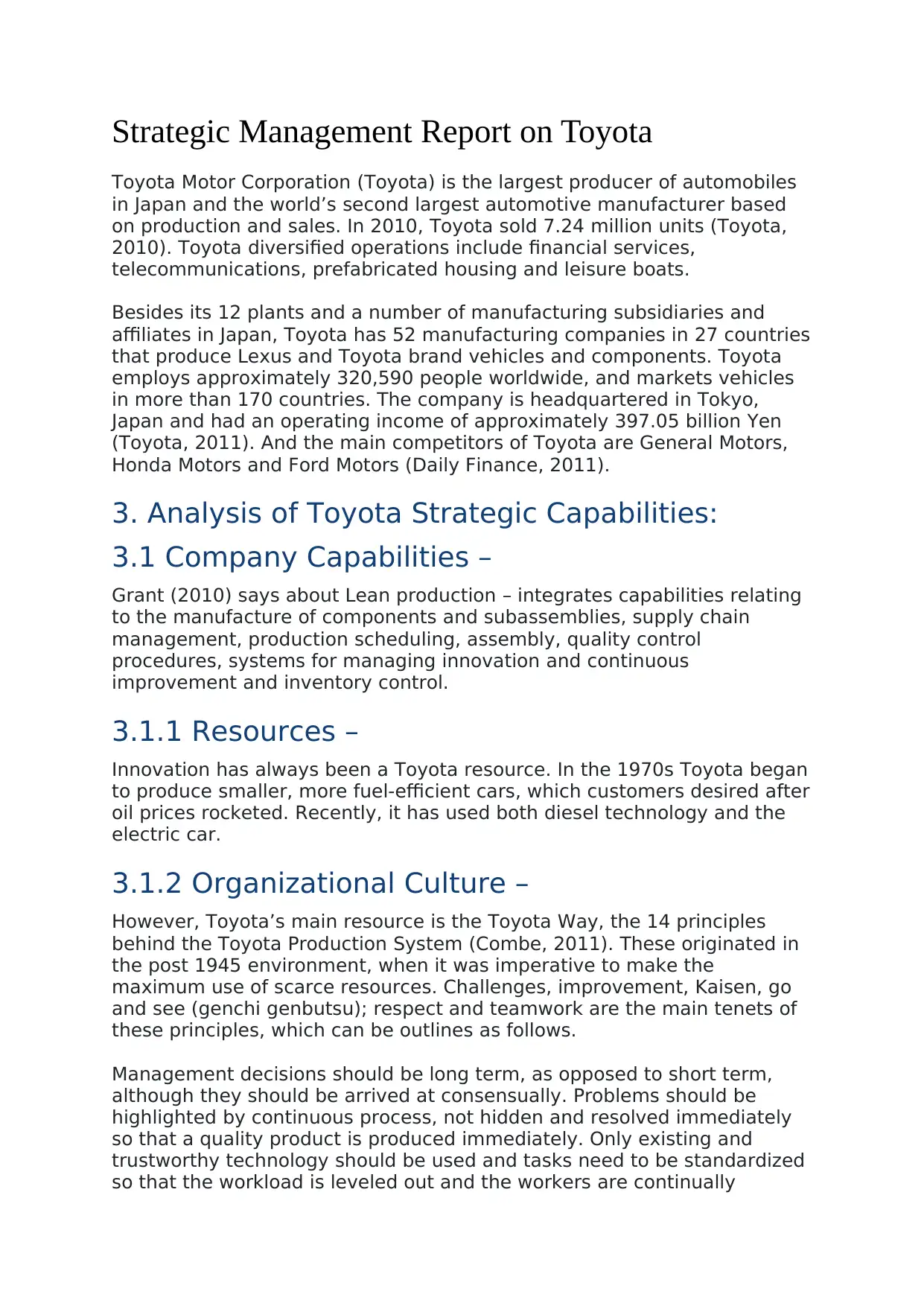
Strategic Management Report on Toyota
Toyota Motor Corporation (Toyota) is the largest producer of automobiles
in Japan and the world’s second largest automotive manufacturer based
on production and sales. In 2010, Toyota sold 7.24 million units (Toyota,
2010). Toyota diversified operations include financial services,
telecommunications, prefabricated housing and leisure boats.
Besides its 12 plants and a number of manufacturing subsidiaries and
affiliates in Japan, Toyota has 52 manufacturing companies in 27 countries
that produce Lexus and Toyota brand vehicles and components. Toyota
employs approximately 320,590 people worldwide, and markets vehicles
in more than 170 countries. The company is headquartered in Tokyo,
Japan and had an operating income of approximately 397.05 billion Yen
(Toyota, 2011). And the main competitors of Toyota are General Motors,
Honda Motors and Ford Motors (Daily Finance, 2011).
3. Analysis of Toyota Strategic Capabilities:
3.1 Company Capabilities –
Grant (2010) says about Lean production – integrates capabilities relating
to the manufacture of components and subassemblies, supply chain
management, production scheduling, assembly, quality control
procedures, systems for managing innovation and continuous
improvement and inventory control.
3.1.1 Resources –
Innovation has always been a Toyota resource. In the 1970s Toyota began
to produce smaller, more fuel-efficient cars, which customers desired after
oil prices rocketed. Recently, it has used both diesel technology and the
electric car.
3.1.2 Organizational Culture –
However, Toyota’s main resource is the Toyota Way, the 14 principles
behind the Toyota Production System (Combe, 2011). These originated in
the post 1945 environment, when it was imperative to make the
maximum use of scarce resources. Challenges, improvement, Kaisen, go
and see (genchi genbutsu); respect and teamwork are the main tenets of
these principles, which can be outlines as follows.
Management decisions should be long term, as opposed to short term,
although they should be arrived at consensually. Problems should be
highlighted by continuous process, not hidden and resolved immediately
so that a quality product is produced immediately. Only existing and
trustworthy technology should be used and tasks need to be standardized
so that the workload is leveled out and the workers are continually
Toyota Motor Corporation (Toyota) is the largest producer of automobiles
in Japan and the world’s second largest automotive manufacturer based
on production and sales. In 2010, Toyota sold 7.24 million units (Toyota,
2010). Toyota diversified operations include financial services,
telecommunications, prefabricated housing and leisure boats.
Besides its 12 plants and a number of manufacturing subsidiaries and
affiliates in Japan, Toyota has 52 manufacturing companies in 27 countries
that produce Lexus and Toyota brand vehicles and components. Toyota
employs approximately 320,590 people worldwide, and markets vehicles
in more than 170 countries. The company is headquartered in Tokyo,
Japan and had an operating income of approximately 397.05 billion Yen
(Toyota, 2011). And the main competitors of Toyota are General Motors,
Honda Motors and Ford Motors (Daily Finance, 2011).
3. Analysis of Toyota Strategic Capabilities:
3.1 Company Capabilities –
Grant (2010) says about Lean production – integrates capabilities relating
to the manufacture of components and subassemblies, supply chain
management, production scheduling, assembly, quality control
procedures, systems for managing innovation and continuous
improvement and inventory control.
3.1.1 Resources –
Innovation has always been a Toyota resource. In the 1970s Toyota began
to produce smaller, more fuel-efficient cars, which customers desired after
oil prices rocketed. Recently, it has used both diesel technology and the
electric car.
3.1.2 Organizational Culture –
However, Toyota’s main resource is the Toyota Way, the 14 principles
behind the Toyota Production System (Combe, 2011). These originated in
the post 1945 environment, when it was imperative to make the
maximum use of scarce resources. Challenges, improvement, Kaisen, go
and see (genchi genbutsu); respect and teamwork are the main tenets of
these principles, which can be outlines as follows.
Management decisions should be long term, as opposed to short term,
although they should be arrived at consensually. Problems should be
highlighted by continuous process, not hidden and resolved immediately
so that a quality product is produced immediately. Only existing and
trustworthy technology should be used and tasks need to be standardized
so that the workload is leveled out and the workers are continually
Paraphrase This Document
Need a fresh take? Get an instant paraphrase of this document with our AI Paraphraser
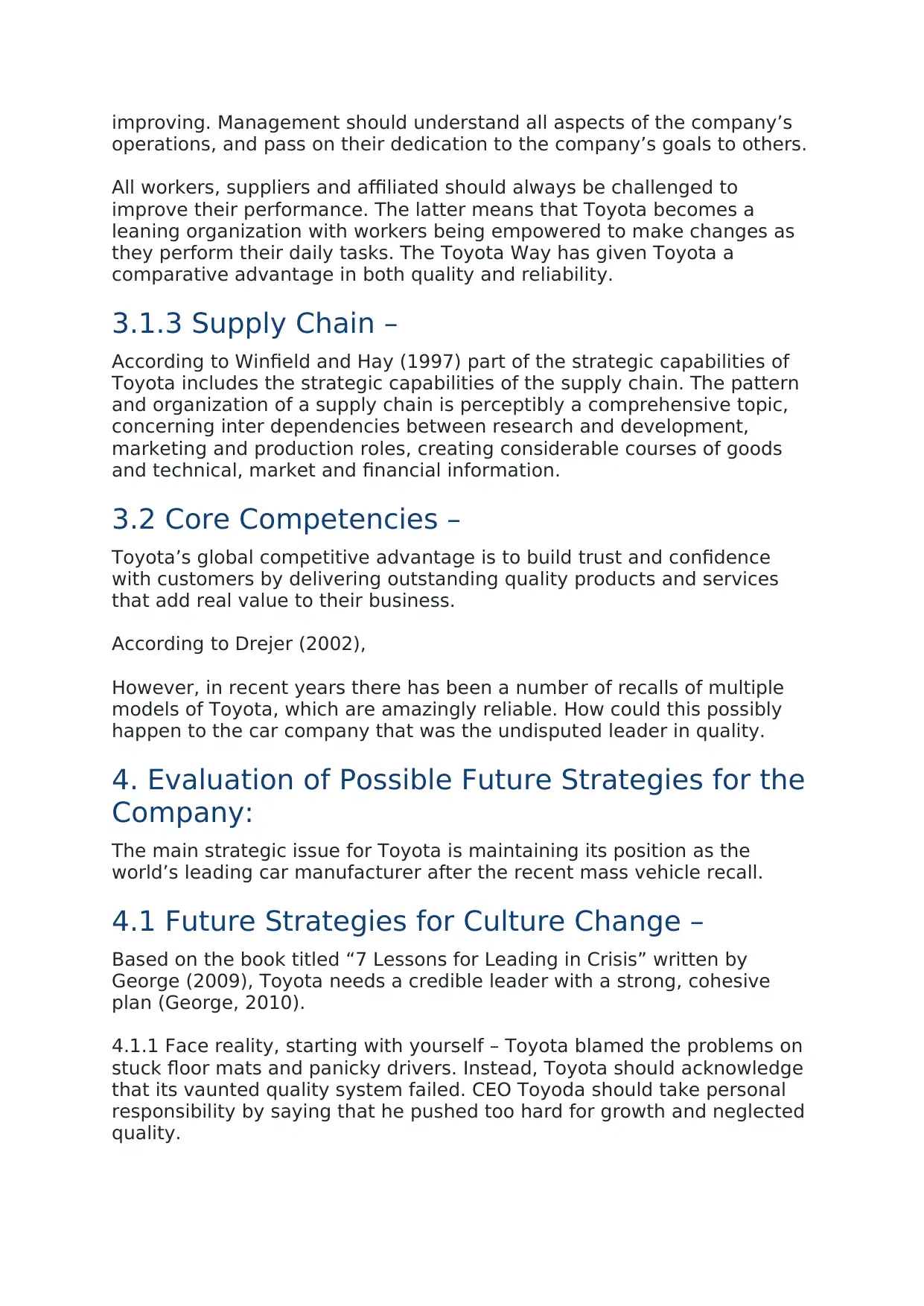
improving. Management should understand all aspects of the company’s
operations, and pass on their dedication to the company’s goals to others.
All workers, suppliers and affiliated should always be challenged to
improve their performance. The latter means that Toyota becomes a
leaning organization with workers being empowered to make changes as
they perform their daily tasks. The Toyota Way has given Toyota a
comparative advantage in both quality and reliability.
3.1.3 Supply Chain –
According to Winfield and Hay (1997) part of the strategic capabilities of
Toyota includes the strategic capabilities of the supply chain. The pattern
and organization of a supply chain is perceptibly a comprehensive topic,
concerning inter dependencies between research and development,
marketing and production roles, creating considerable courses of goods
and technical, market and financial information.
3.2 Core Competencies –
Toyota’s global competitive advantage is to build trust and confidence
with customers by delivering outstanding quality products and services
that add real value to their business.
According to Drejer (2002),
However, in recent years there has been a number of recalls of multiple
models of Toyota, which are amazingly reliable. How could this possibly
happen to the car company that was the undisputed leader in quality.
4. Evaluation of Possible Future Strategies for the
Company:
The main strategic issue for Toyota is maintaining its position as the
world’s leading car manufacturer after the recent mass vehicle recall.
4.1 Future Strategies for Culture Change –
Based on the book titled “7 Lessons for Leading in Crisis” written by
George (2009), Toyota needs a credible leader with a strong, cohesive
plan (George, 2010).
4.1.1 Face reality, starting with yourself – Toyota blamed the problems on
stuck floor mats and panicky drivers. Instead, Toyota should acknowledge
that its vaunted quality system failed. CEO Toyoda should take personal
responsibility by saying that he pushed too hard for growth and neglected
quality.
operations, and pass on their dedication to the company’s goals to others.
All workers, suppliers and affiliated should always be challenged to
improve their performance. The latter means that Toyota becomes a
leaning organization with workers being empowered to make changes as
they perform their daily tasks. The Toyota Way has given Toyota a
comparative advantage in both quality and reliability.
3.1.3 Supply Chain –
According to Winfield and Hay (1997) part of the strategic capabilities of
Toyota includes the strategic capabilities of the supply chain. The pattern
and organization of a supply chain is perceptibly a comprehensive topic,
concerning inter dependencies between research and development,
marketing and production roles, creating considerable courses of goods
and technical, market and financial information.
3.2 Core Competencies –
Toyota’s global competitive advantage is to build trust and confidence
with customers by delivering outstanding quality products and services
that add real value to their business.
According to Drejer (2002),
However, in recent years there has been a number of recalls of multiple
models of Toyota, which are amazingly reliable. How could this possibly
happen to the car company that was the undisputed leader in quality.
4. Evaluation of Possible Future Strategies for the
Company:
The main strategic issue for Toyota is maintaining its position as the
world’s leading car manufacturer after the recent mass vehicle recall.
4.1 Future Strategies for Culture Change –
Based on the book titled “7 Lessons for Leading in Crisis” written by
George (2009), Toyota needs a credible leader with a strong, cohesive
plan (George, 2010).
4.1.1 Face reality, starting with yourself – Toyota blamed the problems on
stuck floor mats and panicky drivers. Instead, Toyota should acknowledge
that its vaunted quality system failed. CEO Toyoda should take personal
responsibility by saying that he pushed too hard for growth and neglected
quality.
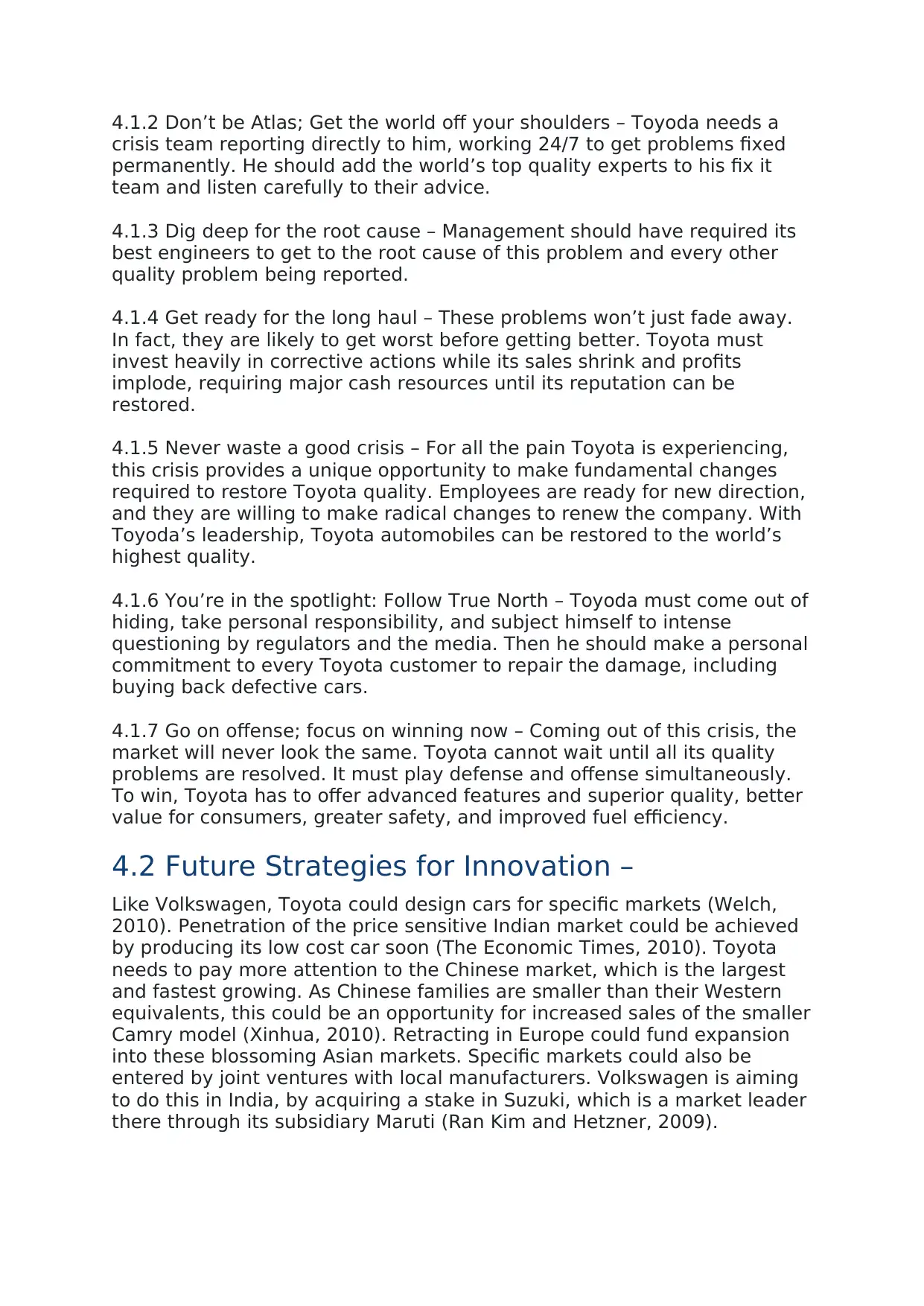
4.1.2 Don’t be Atlas; Get the world off your shoulders – Toyoda needs a
crisis team reporting directly to him, working 24/7 to get problems fixed
permanently. He should add the world’s top quality experts to his fix it
team and listen carefully to their advice.
4.1.3 Dig deep for the root cause – Management should have required its
best engineers to get to the root cause of this problem and every other
quality problem being reported.
4.1.4 Get ready for the long haul – These problems won’t just fade away.
In fact, they are likely to get worst before getting better. Toyota must
invest heavily in corrective actions while its sales shrink and profits
implode, requiring major cash resources until its reputation can be
restored.
4.1.5 Never waste a good crisis – For all the pain Toyota is experiencing,
this crisis provides a unique opportunity to make fundamental changes
required to restore Toyota quality. Employees are ready for new direction,
and they are willing to make radical changes to renew the company. With
Toyoda’s leadership, Toyota automobiles can be restored to the world’s
highest quality.
4.1.6 You’re in the spotlight: Follow True North – Toyoda must come out of
hiding, take personal responsibility, and subject himself to intense
questioning by regulators and the media. Then he should make a personal
commitment to every Toyota customer to repair the damage, including
buying back defective cars.
4.1.7 Go on offense; focus on winning now – Coming out of this crisis, the
market will never look the same. Toyota cannot wait until all its quality
problems are resolved. It must play defense and offense simultaneously.
To win, Toyota has to offer advanced features and superior quality, better
value for consumers, greater safety, and improved fuel efficiency.
4.2 Future Strategies for Innovation –
Like Volkswagen, Toyota could design cars for specific markets (Welch,
2010). Penetration of the price sensitive Indian market could be achieved
by producing its low cost car soon (The Economic Times, 2010). Toyota
needs to pay more attention to the Chinese market, which is the largest
and fastest growing. As Chinese families are smaller than their Western
equivalents, this could be an opportunity for increased sales of the smaller
Camry model (Xinhua, 2010). Retracting in Europe could fund expansion
into these blossoming Asian markets. Specific markets could also be
entered by joint ventures with local manufacturers. Volkswagen is aiming
to do this in India, by acquiring a stake in Suzuki, which is a market leader
there through its subsidiary Maruti (Ran Kim and Hetzner, 2009).
crisis team reporting directly to him, working 24/7 to get problems fixed
permanently. He should add the world’s top quality experts to his fix it
team and listen carefully to their advice.
4.1.3 Dig deep for the root cause – Management should have required its
best engineers to get to the root cause of this problem and every other
quality problem being reported.
4.1.4 Get ready for the long haul – These problems won’t just fade away.
In fact, they are likely to get worst before getting better. Toyota must
invest heavily in corrective actions while its sales shrink and profits
implode, requiring major cash resources until its reputation can be
restored.
4.1.5 Never waste a good crisis – For all the pain Toyota is experiencing,
this crisis provides a unique opportunity to make fundamental changes
required to restore Toyota quality. Employees are ready for new direction,
and they are willing to make radical changes to renew the company. With
Toyoda’s leadership, Toyota automobiles can be restored to the world’s
highest quality.
4.1.6 You’re in the spotlight: Follow True North – Toyoda must come out of
hiding, take personal responsibility, and subject himself to intense
questioning by regulators and the media. Then he should make a personal
commitment to every Toyota customer to repair the damage, including
buying back defective cars.
4.1.7 Go on offense; focus on winning now – Coming out of this crisis, the
market will never look the same. Toyota cannot wait until all its quality
problems are resolved. It must play defense and offense simultaneously.
To win, Toyota has to offer advanced features and superior quality, better
value for consumers, greater safety, and improved fuel efficiency.
4.2 Future Strategies for Innovation –
Like Volkswagen, Toyota could design cars for specific markets (Welch,
2010). Penetration of the price sensitive Indian market could be achieved
by producing its low cost car soon (The Economic Times, 2010). Toyota
needs to pay more attention to the Chinese market, which is the largest
and fastest growing. As Chinese families are smaller than their Western
equivalents, this could be an opportunity for increased sales of the smaller
Camry model (Xinhua, 2010). Retracting in Europe could fund expansion
into these blossoming Asian markets. Specific markets could also be
entered by joint ventures with local manufacturers. Volkswagen is aiming
to do this in India, by acquiring a stake in Suzuki, which is a market leader
there through its subsidiary Maruti (Ran Kim and Hetzner, 2009).
⊘ This is a preview!⊘
Do you want full access?
Subscribe today to unlock all pages.

Trusted by 1+ million students worldwide
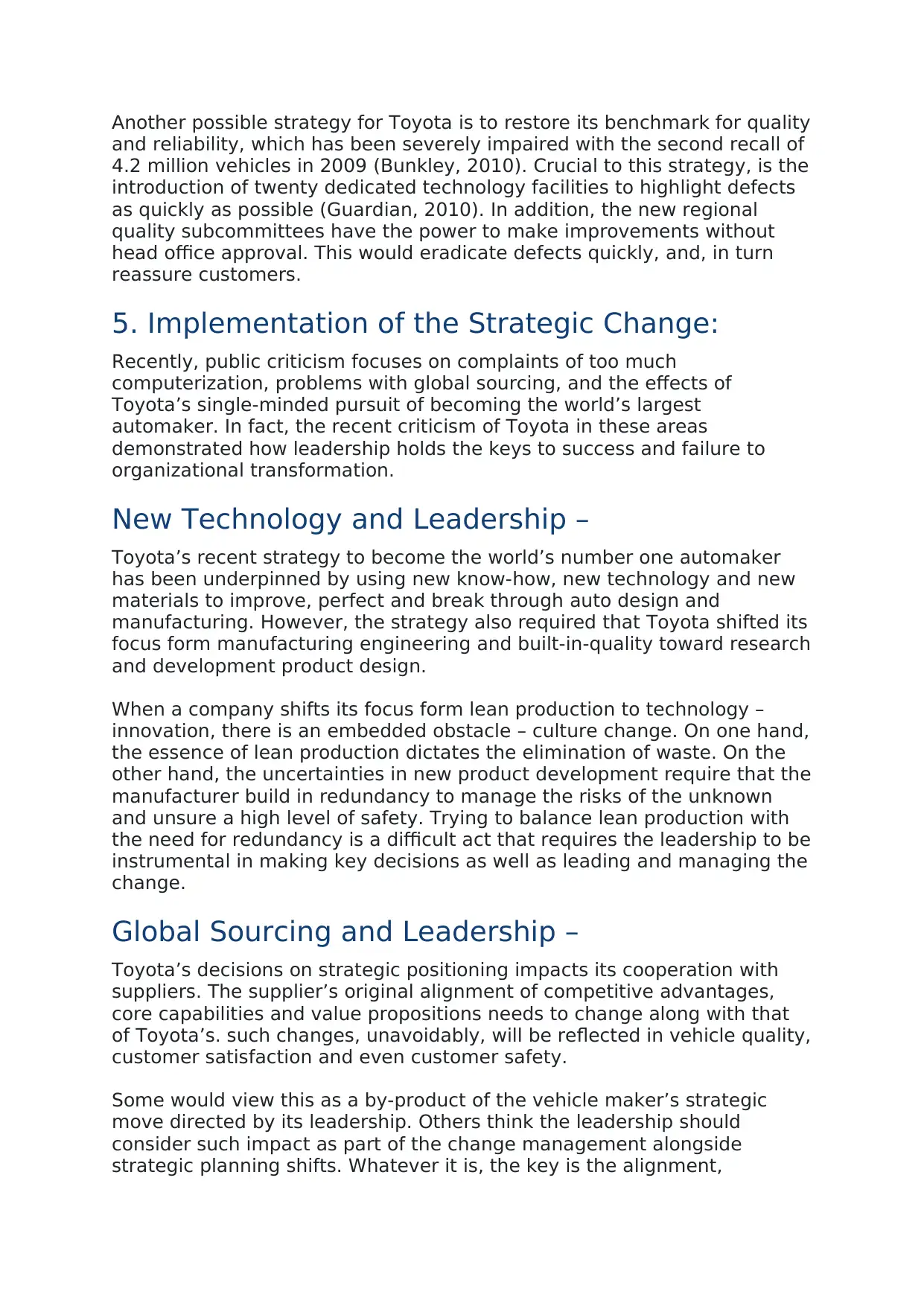
Another possible strategy for Toyota is to restore its benchmark for quality
and reliability, which has been severely impaired with the second recall of
4.2 million vehicles in 2009 (Bunkley, 2010). Crucial to this strategy, is the
introduction of twenty dedicated technology facilities to highlight defects
as quickly as possible (Guardian, 2010). In addition, the new regional
quality subcommittees have the power to make improvements without
head office approval. This would eradicate defects quickly, and, in turn
reassure customers.
5. Implementation of the Strategic Change:
Recently, public criticism focuses on complaints of too much
computerization, problems with global sourcing, and the effects of
Toyota’s single-minded pursuit of becoming the world’s largest
automaker. In fact, the recent criticism of Toyota in these areas
demonstrated how leadership holds the keys to success and failure to
organizational transformation.
New Technology and Leadership –
Toyota’s recent strategy to become the world’s number one automaker
has been underpinned by using new know-how, new technology and new
materials to improve, perfect and break through auto design and
manufacturing. However, the strategy also required that Toyota shifted its
focus form manufacturing engineering and built-in-quality toward research
and development product design.
When a company shifts its focus form lean production to technology –
innovation, there is an embedded obstacle – culture change. On one hand,
the essence of lean production dictates the elimination of waste. On the
other hand, the uncertainties in new product development require that the
manufacturer build in redundancy to manage the risks of the unknown
and unsure a high level of safety. Trying to balance lean production with
the need for redundancy is a difficult act that requires the leadership to be
instrumental in making key decisions as well as leading and managing the
change.
Global Sourcing and Leadership –
Toyota’s decisions on strategic positioning impacts its cooperation with
suppliers. The supplier’s original alignment of competitive advantages,
core capabilities and value propositions needs to change along with that
of Toyota’s. such changes, unavoidably, will be reflected in vehicle quality,
customer satisfaction and even customer safety.
Some would view this as a by-product of the vehicle maker’s strategic
move directed by its leadership. Others think the leadership should
consider such impact as part of the change management alongside
strategic planning shifts. Whatever it is, the key is the alignment,
and reliability, which has been severely impaired with the second recall of
4.2 million vehicles in 2009 (Bunkley, 2010). Crucial to this strategy, is the
introduction of twenty dedicated technology facilities to highlight defects
as quickly as possible (Guardian, 2010). In addition, the new regional
quality subcommittees have the power to make improvements without
head office approval. This would eradicate defects quickly, and, in turn
reassure customers.
5. Implementation of the Strategic Change:
Recently, public criticism focuses on complaints of too much
computerization, problems with global sourcing, and the effects of
Toyota’s single-minded pursuit of becoming the world’s largest
automaker. In fact, the recent criticism of Toyota in these areas
demonstrated how leadership holds the keys to success and failure to
organizational transformation.
New Technology and Leadership –
Toyota’s recent strategy to become the world’s number one automaker
has been underpinned by using new know-how, new technology and new
materials to improve, perfect and break through auto design and
manufacturing. However, the strategy also required that Toyota shifted its
focus form manufacturing engineering and built-in-quality toward research
and development product design.
When a company shifts its focus form lean production to technology –
innovation, there is an embedded obstacle – culture change. On one hand,
the essence of lean production dictates the elimination of waste. On the
other hand, the uncertainties in new product development require that the
manufacturer build in redundancy to manage the risks of the unknown
and unsure a high level of safety. Trying to balance lean production with
the need for redundancy is a difficult act that requires the leadership to be
instrumental in making key decisions as well as leading and managing the
change.
Global Sourcing and Leadership –
Toyota’s decisions on strategic positioning impacts its cooperation with
suppliers. The supplier’s original alignment of competitive advantages,
core capabilities and value propositions needs to change along with that
of Toyota’s. such changes, unavoidably, will be reflected in vehicle quality,
customer satisfaction and even customer safety.
Some would view this as a by-product of the vehicle maker’s strategic
move directed by its leadership. Others think the leadership should
consider such impact as part of the change management alongside
strategic planning shifts. Whatever it is, the key is the alignment,
Paraphrase This Document
Need a fresh take? Get an instant paraphrase of this document with our AI Paraphraser
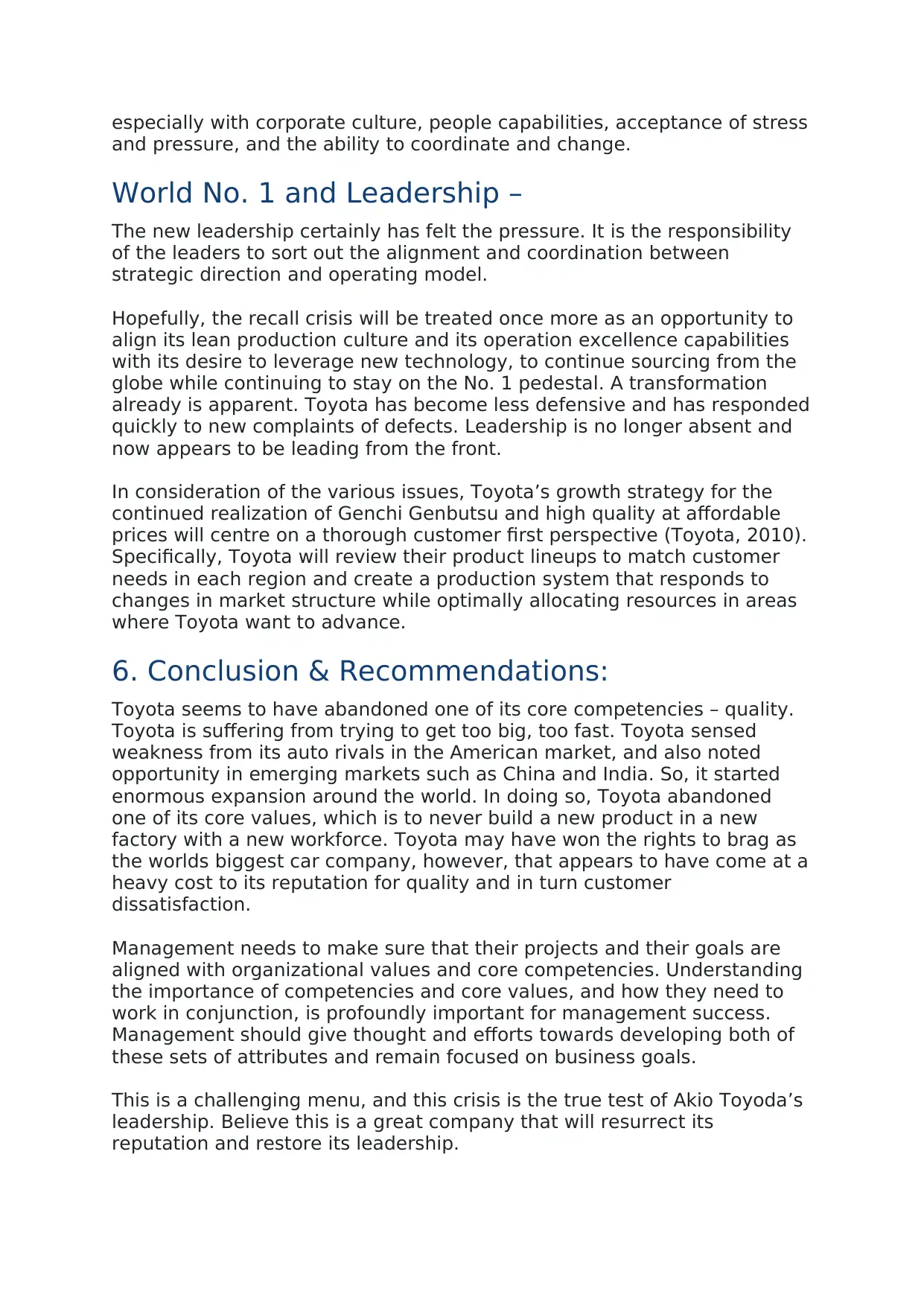
especially with corporate culture, people capabilities, acceptance of stress
and pressure, and the ability to coordinate and change.
World No. 1 and Leadership –
The new leadership certainly has felt the pressure. It is the responsibility
of the leaders to sort out the alignment and coordination between
strategic direction and operating model.
Hopefully, the recall crisis will be treated once more as an opportunity to
align its lean production culture and its operation excellence capabilities
with its desire to leverage new technology, to continue sourcing from the
globe while continuing to stay on the No. 1 pedestal. A transformation
already is apparent. Toyota has become less defensive and has responded
quickly to new complaints of defects. Leadership is no longer absent and
now appears to be leading from the front.
In consideration of the various issues, Toyota’s growth strategy for the
continued realization of Genchi Genbutsu and high quality at affordable
prices will centre on a thorough customer first perspective (Toyota, 2010).
Specifically, Toyota will review their product lineups to match customer
needs in each region and create a production system that responds to
changes in market structure while optimally allocating resources in areas
where Toyota want to advance.
6. Conclusion & Recommendations:
Toyota seems to have abandoned one of its core competencies – quality.
Toyota is suffering from trying to get too big, too fast. Toyota sensed
weakness from its auto rivals in the American market, and also noted
opportunity in emerging markets such as China and India. So, it started
enormous expansion around the world. In doing so, Toyota abandoned
one of its core values, which is to never build a new product in a new
factory with a new workforce. Toyota may have won the rights to brag as
the worlds biggest car company, however, that appears to have come at a
heavy cost to its reputation for quality and in turn customer
dissatisfaction.
Management needs to make sure that their projects and their goals are
aligned with organizational values and core competencies. Understanding
the importance of competencies and core values, and how they need to
work in conjunction, is profoundly important for management success.
Management should give thought and efforts towards developing both of
these sets of attributes and remain focused on business goals.
This is a challenging menu, and this crisis is the true test of Akio Toyoda’s
leadership. Believe this is a great company that will resurrect its
reputation and restore its leadership.
and pressure, and the ability to coordinate and change.
World No. 1 and Leadership –
The new leadership certainly has felt the pressure. It is the responsibility
of the leaders to sort out the alignment and coordination between
strategic direction and operating model.
Hopefully, the recall crisis will be treated once more as an opportunity to
align its lean production culture and its operation excellence capabilities
with its desire to leverage new technology, to continue sourcing from the
globe while continuing to stay on the No. 1 pedestal. A transformation
already is apparent. Toyota has become less defensive and has responded
quickly to new complaints of defects. Leadership is no longer absent and
now appears to be leading from the front.
In consideration of the various issues, Toyota’s growth strategy for the
continued realization of Genchi Genbutsu and high quality at affordable
prices will centre on a thorough customer first perspective (Toyota, 2010).
Specifically, Toyota will review their product lineups to match customer
needs in each region and create a production system that responds to
changes in market structure while optimally allocating resources in areas
where Toyota want to advance.
6. Conclusion & Recommendations:
Toyota seems to have abandoned one of its core competencies – quality.
Toyota is suffering from trying to get too big, too fast. Toyota sensed
weakness from its auto rivals in the American market, and also noted
opportunity in emerging markets such as China and India. So, it started
enormous expansion around the world. In doing so, Toyota abandoned
one of its core values, which is to never build a new product in a new
factory with a new workforce. Toyota may have won the rights to brag as
the worlds biggest car company, however, that appears to have come at a
heavy cost to its reputation for quality and in turn customer
dissatisfaction.
Management needs to make sure that their projects and their goals are
aligned with organizational values and core competencies. Understanding
the importance of competencies and core values, and how they need to
work in conjunction, is profoundly important for management success.
Management should give thought and efforts towards developing both of
these sets of attributes and remain focused on business goals.
This is a challenging menu, and this crisis is the true test of Akio Toyoda’s
leadership. Believe this is a great company that will resurrect its
reputation and restore its leadership.

⊘ This is a preview!⊘
Do you want full access?
Subscribe today to unlock all pages.

Trusted by 1+ million students worldwide
1 out of 6
Related Documents
Your All-in-One AI-Powered Toolkit for Academic Success.
+13062052269
info@desklib.com
Available 24*7 on WhatsApp / Email
![[object Object]](/_next/static/media/star-bottom.7253800d.svg)
Unlock your academic potential
Copyright © 2020–2025 A2Z Services. All Rights Reserved. Developed and managed by ZUCOL.





